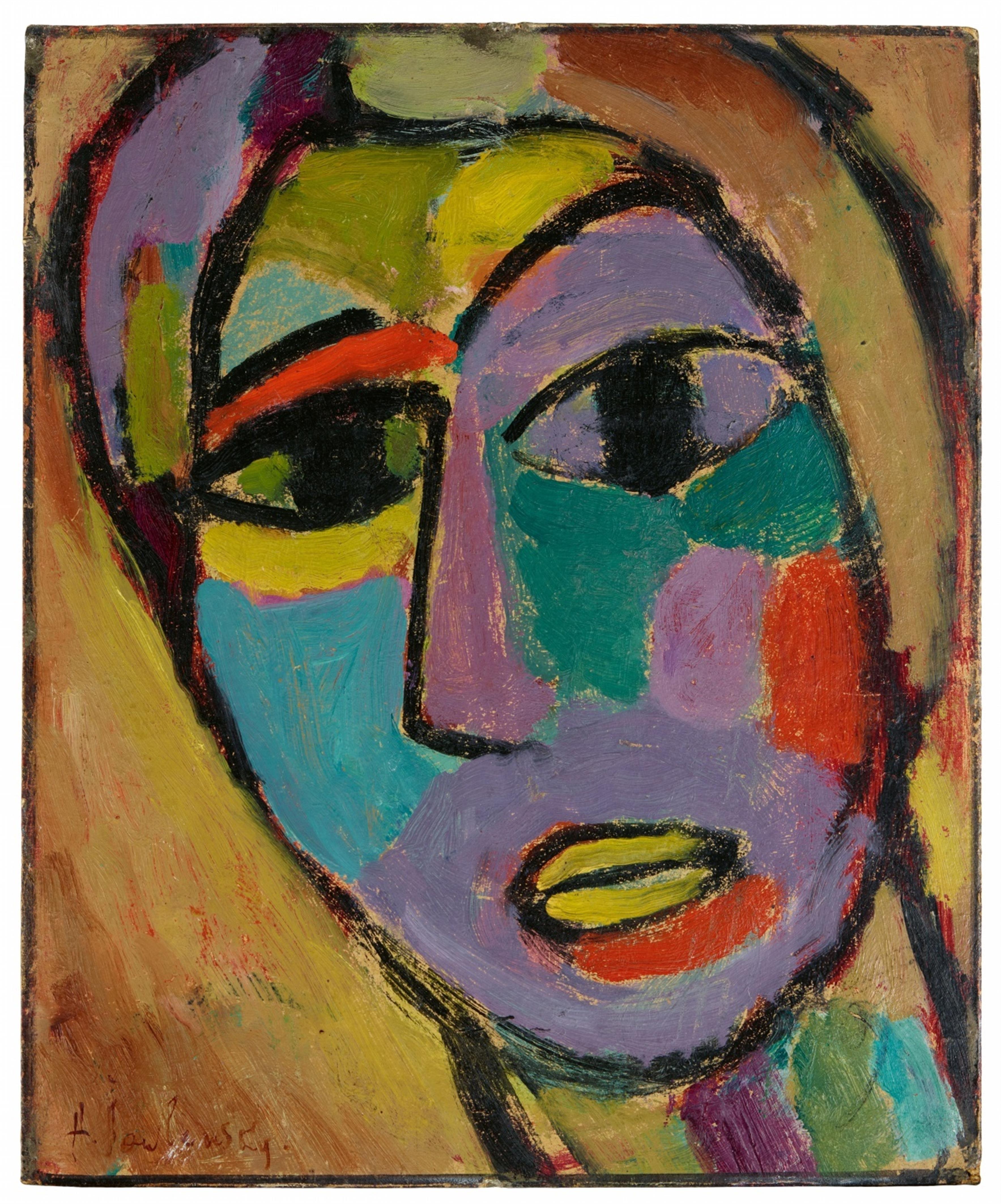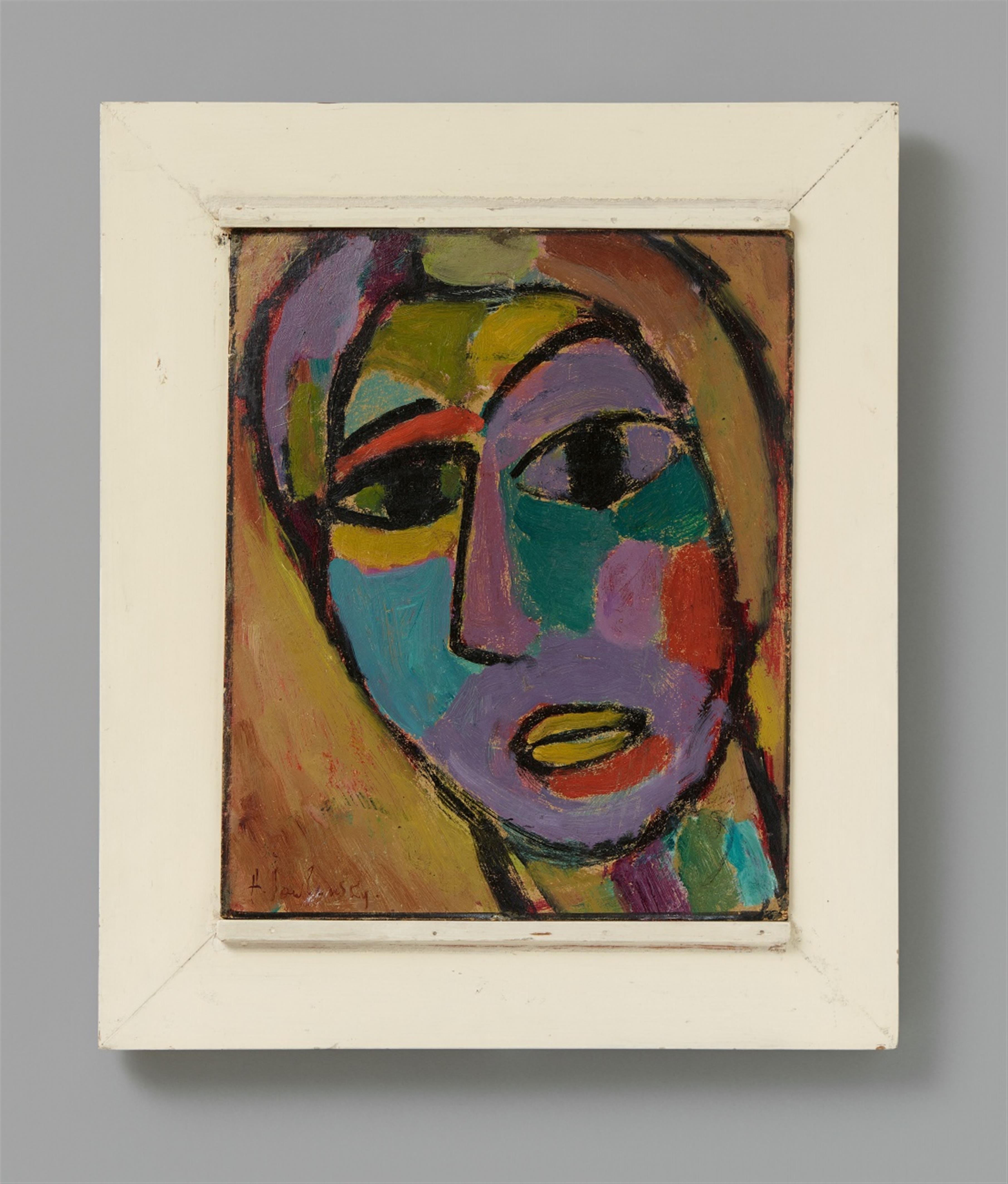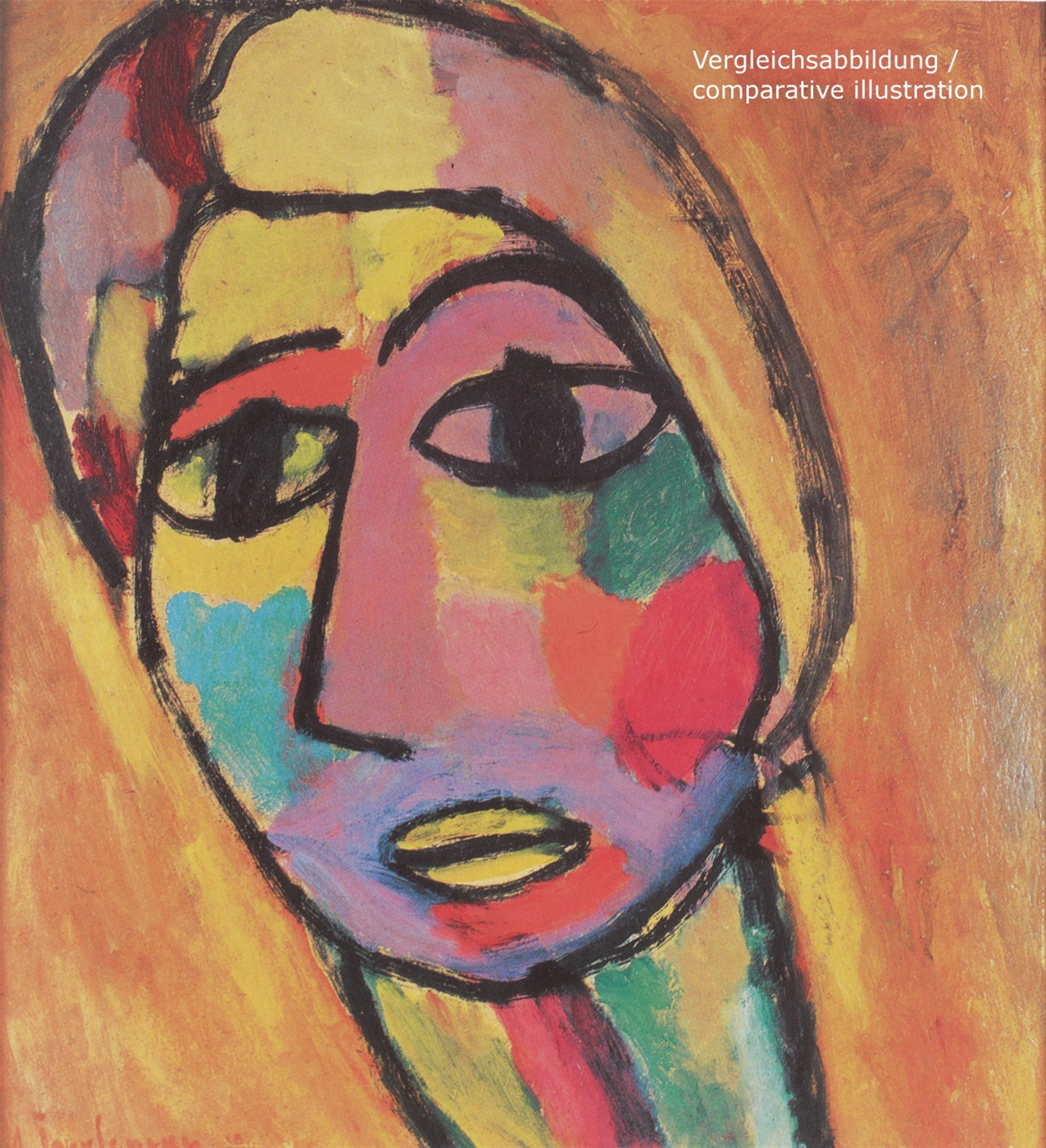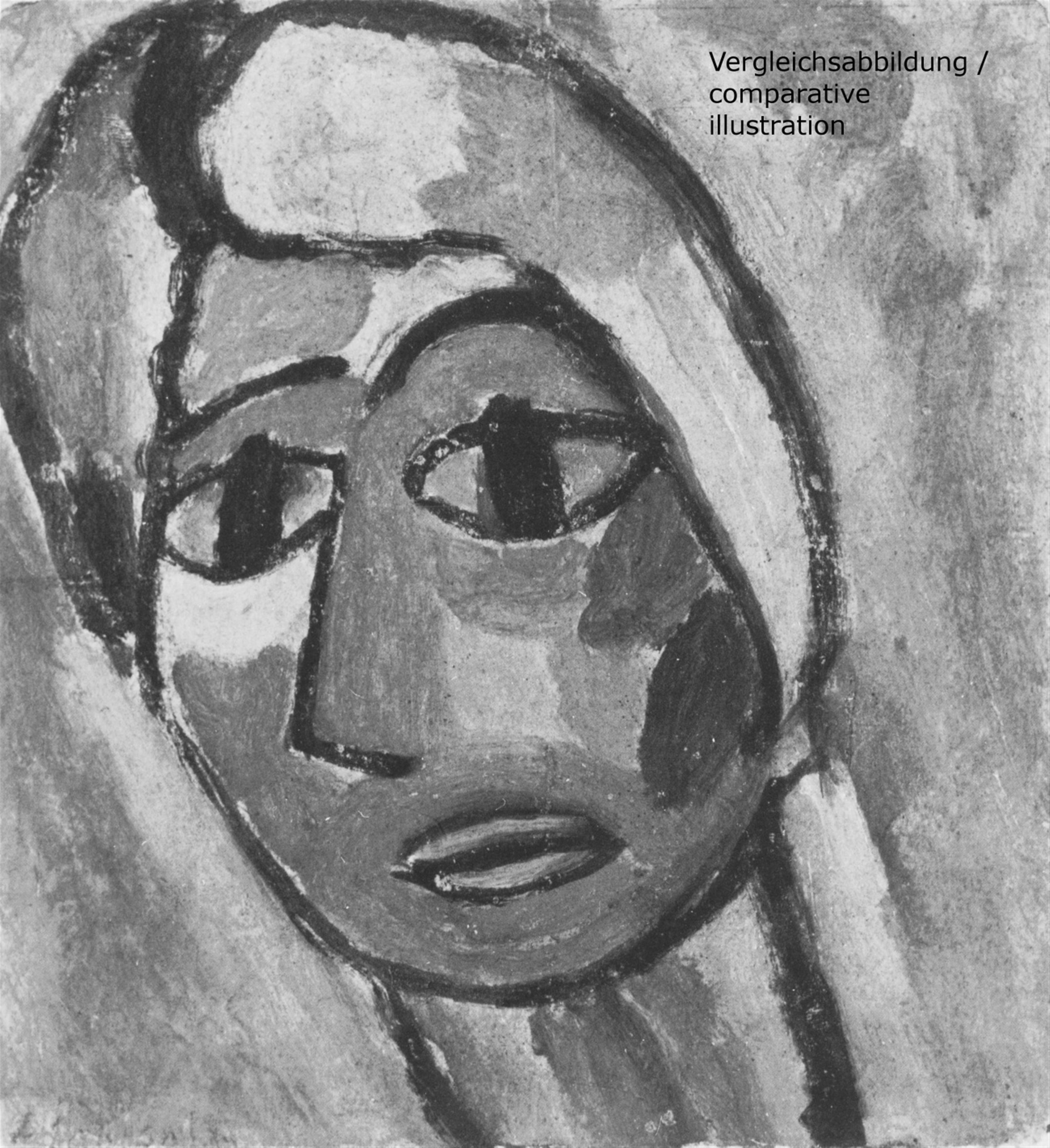Alexej von Jawlensky
Mystischer Kopf: Erde
1919
Oil on card 35.7 x 29.6 cm In original frame. Signed 'A. Jawlensky' in red lower left and titled, dated and signed 'Nach dem Kopf "Erde" 19 A. v. Jawlensky' verso. - Minute traces of nails in the narrow black margin, the right corner minimally torn. An overpainted composition of a further head in red-brown verso.
Emmy Scheyer, whom Alexej von Jawlensky later called “Galka” (black bird), met the painter in 1916 during his exile in Switzerland, where he had emigrated after being expelled from Germany on account of the war. A spiritual gravitation and deep mutual friendship would define their work together until Jawlensky's death. Scheyer wrote articles and organised exhibitions of Jawlensky's art, for example, the major travelling exhibition in the early 1920s which presented his work - presumably also including the “Mystischer Kopf: Erde” offered here - in all of Germany's major art centres.
While Jawlensky had already recorded the view from his studio window in Saint-Prex in his highly diverse “Variationen”, in 1917 the painter had increasingly begun to occupy himself with his different series of primarily female heads. “Mystischer Kopf: Erde”, which is also from this period, was preceded by two quite similar works assigned the same title (see comparative illustrations). Scheyer would take these two works with her to America in the 1920s - one was later sold by her and she kept one for her collection, which entered the Norton Simon Museum of Art at Pasadena as a bequest in the early 1970s (see M. Jawlensky/Pieroni-Jawlensky/A. Jawlensky 962, 963; Sara Campbell, ed., The Blue Four: Galka Scheyer Collection, Los Angeles 1972, cat. no. 139 with ill.).
Scheyer met Lyonel Feininger, Wassily Kandinsky and Paul Klee in the early 1920s. Together with Jawlensky these painters would join together to form a loose group and, in an allusion to the “Blauer Reiter” (blue rider), they referred to themselves as the “Blaue Vier” (blue four). Probably also due to the economic context - a dramatically intensifying inflation reigned in Germany's Weimar Republic - the “Blaue Vier” concluded a kind of contract with Scheyer in 1924 to serve “to promote the dissemination of their artistic ideas abroad, particularly through lectures and exhibitions. For this purpose they [the artists] consign to Ms Emmy Scheyer, who will soon be journeying to America, a number of pictures and other material, so that Ms Scheyer will act on their behalf in the indicated sense. […]” (cited in: Feininger, Jawlensky, Kandinsky, Paul Klee: Galka Scheyer zeigt The Blue Four in Amerika, in: du, June 1975, p. 21).
It certainly cannot be ruled out that the “Mystische Köpfe” were inspired by Scheyer's strong personality and that, in the words of Anne Mochon, “her striking face, with its curved nose and projecting chin, provided the impulse for a new idea of the feminine presence in his work.” (id., Inneres Schauen: Galka Scheyer und Alexej Jawlensky, in: exhib. cat. Alexej Jawlensky, Locarno 1989, p. 150). However, the little series of the three “Mystische Köpfe: Erde” is distinguished by a high degree of abstraction that goes beyond any characteristic portrait-like resemblance.
The physiognomy of “Erde”, the head offered here, is constructed out of individual, two-dimensional, unmodulated areas of colour placed against one another; black contours delineate only the outer form and the interior features of the eyes, eyebrows, nose and mouth. Almost seeming to radiate its own light, the female head - which is depicted as large as possible - is fit inside the typical black-edged framing.
“With this step the artist expanded the degree of the objective reduction on the level of an intensified autonomy of colour” (Kornelia von Berswordt-Wallrabe, zu den Aspekten von Fläche und Reihe im Werk Jawlenskys, in: exh. cat. Alexej von Jawlensky zum 50. Todesjahr, Museum Wiesbaden 1991, p. 28).
Our painting “Mystischer Kopf: Erde” captivates through its glowing use of colour, with the paint seemingly applied in a coarsely expressive manner, and through its concentration on the essential.
Catalogue Raisonné
M. Jawlensky/Pieroni-Jawlensky/A. Jawlensky vol. II 1060; Weiler 1959, 235
Certificate
We would like to thank Angelica Jawlensky Bianconi, Alexej von Jawlensky-Archiv, Muralto, for additional informationen and scientific consultation.
Provenance
Galerie Egon Günther, Mannheim (label verso); Galerie Otto Ralfs, Braunschweig; Galerie Hella Nebelung, Düsseldorf; Sammlung Ströher; Lempertz, auction 469, 18 June 1962, Kunst des 20. Jahrhunderts, lot 283, with colour illus. pl. I; Private collection, Baden-Württemberg
Exhibitions
Presumably Berlin/Hamburg/Munich/Hanover/Stuttgart/Frankfurt/Wiesbaden/Wuppertal-Barmen/Mannheim 1920/1921 (Galerie Fritz Gurlitt/Galerie Commeter, and Kunsthalle Hamburg/Galerie Hans Goltz/Kestner-Gesellschaft/Württembergischer Kunstverein/Kunstsalon Ludwig Schames/Neues Museum/Ruhmeshalle/Kunsthalle), Alexej von Jawlensky, cat. no. 26, without illus.; Presumably Dresden 1923 (Neue Kunst Fides); Mannheim 1947 (Galerie Egon Günther), Alexej von Jawlensky, with cover illus.; Braunschweig 1948 (Galerie Otto Ralfs), Alexej von Jawlensky, with cover illus.; Düsseldorf 1949 (Galerie Hella Nebelung), Alexej von Jawlensky und Josef Hegenbarth, with cover illus.; Essen 1998 (Museum Folkwang), Das Auge ist der Richter, cat. no. 52, with full-page colour illus.; Mannheim 2006-2018 (Kunsthalle), permanent loan








